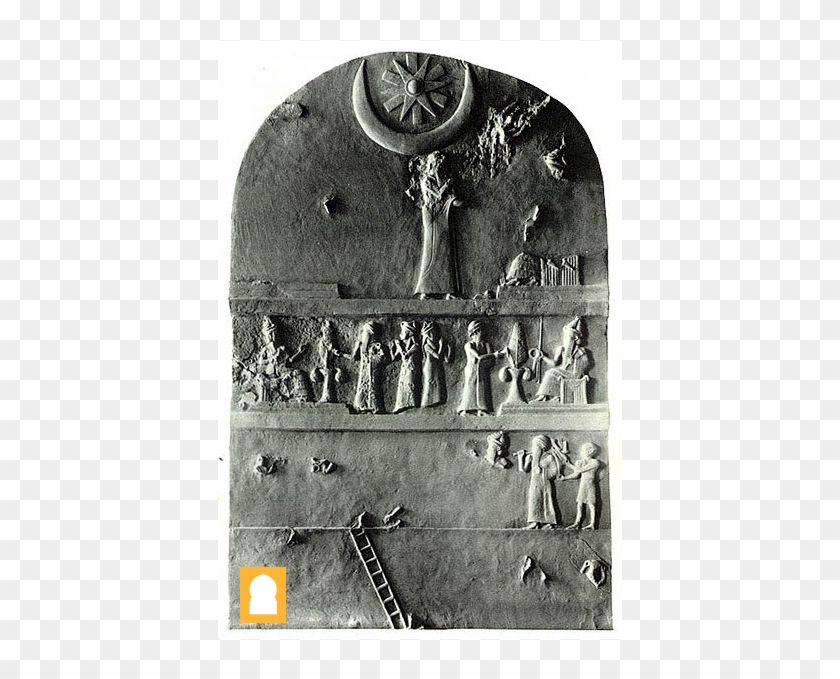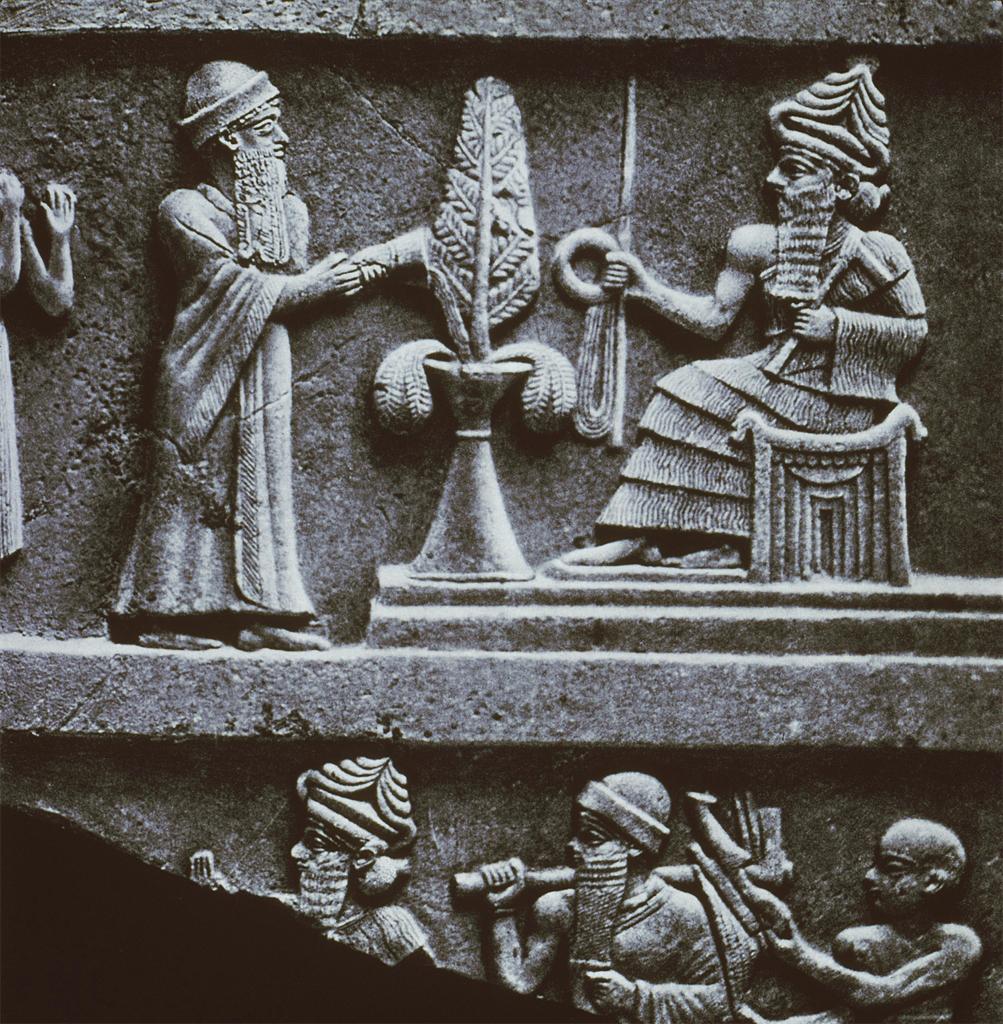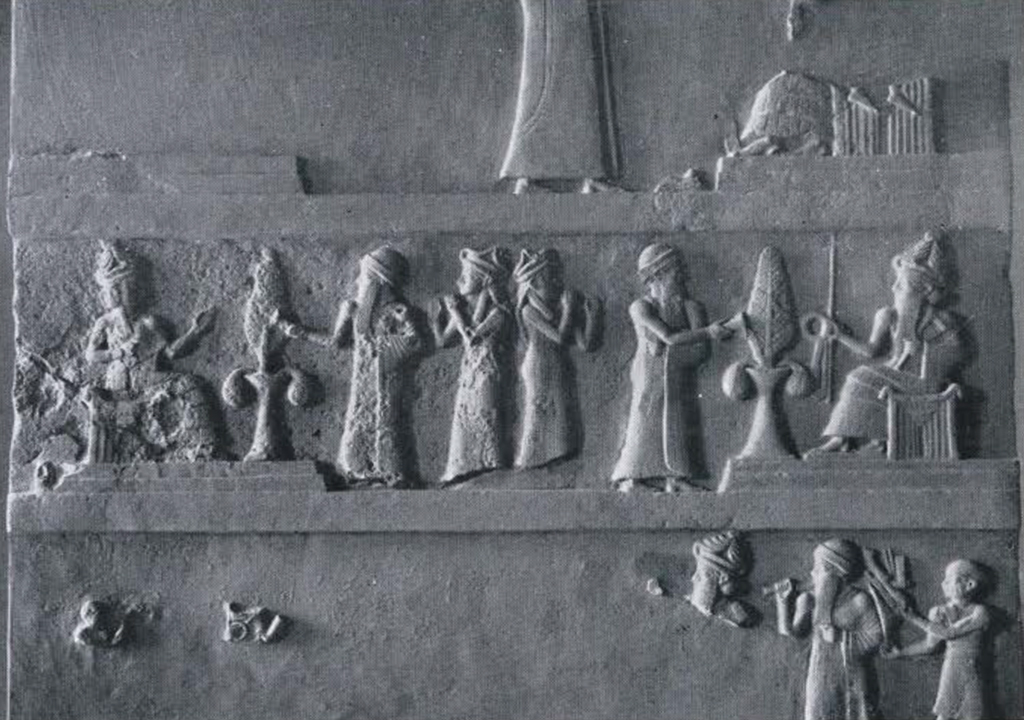
Ur Stele Of Ur Nammu, HD Png Download 636x598(4130293) PngFind
Ur-Nammu (r. 2047-2030 BCE) was the founder of the Third Dynasty of Ur in Sumer who initiated the so-called Ur III Period (2047-1750 BCE) also known as the Sumerian Renaissance. He is best known as the king who composed the oldest extant law code in the world, the Code of Ur-Nammu.. An earlier law code (known as the Code of Urukagina from the 24th century BCE) is only known through partial.

A detail of the Stele of UrNammu showing the moon god Nannar. The... News Photo Getty Images
The stela of Ur-Nammu, the largest sculptured slab recovered at Ur, is a monumental record of the building activities of the founder of the third dynasty. After the Guti had been driven out of the land by Utu-khegal of Uruk, the royalty passed to Ur, and for over a century Ur- Nammu and his successors ruled as kings of Sumer and Akkad, extended.

00/00/1980. A detail from the stele of UrNammu, Sumerian King from... News Photo Getty Images
Penn Museum Object B16676.14 - Ur-Namu Stele. Ur-Namu Stele. B16676.14. Location: On Display in the Middle East Galleries From: Iraq | Ur Curatorial Section: Near Eastern View All (2) Object Images

UrNamu Stele B16676.14 Penn Museum Collections
The stela of Ur-Nammu. The flying angel brings from heaven a vase overflowing with rain water. The king stands worshipping before the enthroned Moon god. The fragment belongs to the top register of the face. It has a similar scene on the reverse as shown on page 76. The stela dates from B.C. 2300.

Ur Nammu Thule Italia
Third Dynasty of Ur, about 2100 BCE, from Babylon, southern Iraq. Length: 5.28 cm Diameter: 2.87 cm. Obtained at Babylon some time before 1820 CE by John Hine and presented to the British Museum by C.D. Cobham by 1880 CE. British Museum, ME 89126, Room 56, Early Mesopotamia, case 20. This seal is typical of the last century of the third and of.

Fragment of the UrNammu Stele Fragment of the UrNammu St… Flickr
The Code of Ur-Nammu (c. 2100-2050 BCE) is the oldest extant law code in the world. It was written by the Sumerian king Ur-Nammu (r. 2047-2030 BCE) or his son Shulgi of Ur (r. 2029-1982 BCE) centuries before the famous Code of Hammurabi was inscribed by the Babylonian king Hammurabi (r. 1795-1750 BCE).. The dating of c. 2100-2050 BCE is based on middle chronology; short chronology places the.
Ur Nammu YouTube
The "Ur-Nammu" Stela Vol.: University Museum Monograph 110.. University of Pennsylvania Museum of Archaeology and Anthropology. Actual Citation : Page/Fig./Plate: 40:12, 46: View Objects related to this Actual Citation [Book] Woolley, Charles L. Ur Excavations: The building of the Third Dynasty.. Published for the Trustees of the Two Museums by.

Ur Nammu Thule Italia
Ur-Nammu (or Ur-Namma, Ur-Engur, Ur-Gur, Sumerian:. Stele of Ur-Nammu, University of Pennsylvania Museum of Archeology and Anthropology. Ur Namma stele detail, Penn Museum. Code of Ur-Nammu. Fired mudbrick, stamped. The cuneiform inscription mentions the name of Ur-Nammu, and there are two presumably accidentally impressed dog's paw-marks.

ART HISTORY 201 Ancient Near Eastern Art The UrNammu Stele
From Uruk, southern Iraq Third Dynasty of Ur, about 2100-2000 BC. The king as a temple builder with a basket of earth to make bricks. This bronze figure represents Ur-Nammu, the ruler of Ur (about 2112-2095 BC).It was made for burial in the foundations of a temple of Uruk. It was one of the duties of a Mesopotamian king to care for the gods and restore or rebuild their temples.

Ur Nammu Alchetron, The Free Social Encyclopedia
The Stele of Ur-Nammu. Although a large trove of administrative documents does exist from this period there is little evidence of the actual details of Ur-Nammu's reign. One notable exception is the Stele of Ur-Nammu. The stele was discovered in 1925 by a joint expedition of the University of Pennsylvania and the British Museum.

The UrNammu Stele Ur Mesopotamia
The "Ur-Nammu" Stela Vol.: University Museum Monograph 110.. University of Pennsylvania Museum of Archaeology and Anthropology. Actual Citation : Page/Fig./Plate: 44:12, 51: View Objects related to this Actual Citation [Book] Woolley, Charles L. Ur Excavations: The building of the Third Dynasty.. Published for the Trustees of the Two Museums by.

A.C.N.R.
Stela of Ur-Nammu, c. 2112-2094 BCE, limestone, 3 × 1.5 m (University of Pennsylvania Museum of Archaeology and Anthropology). This limestone stele, found in a very fragmentary state at Ur, has five narrative layers (registers) on both sides. They likely depict King Ur Nammu building and consecrating the major temple complex at Ur dedicated.

Ancient mesopotamia hires stock photography and images Alamy
The "Ur-Nammu" Stela. Ur-Nammu was king of Ur in ancient Mesopotamia (southern Iraq) around 2000 B.C. In 1925 a joint expedition from the University of Pennsylvania Museum and the British Museum discovered dozens of fragments of a monument in honor of Ur-Nammu. Because such works have rarely survived, the stela became one of the most famous.

stele of urnamma of ur Ancient sumer, Ancient art, Ancient
Stela of Ur-Nammu, King of Ur, circa 2120 B.C. The King worshipping the gods of Ur before the building of the tower. Museum Object Number: B16676. Image Number: 8414. The great slab, as now restored in the Babylonian Section of the University Museum, is 10 feet high, 5 feet wide, and 1 foot thick. Front and back are divided by raised bands into.

UrNammu, founder of Sumerian Third Dynasty of Ur (c. 2040 BC) Arte na antiguidade, Arte
The most ancient legislator known is Ur-Nammu, the founder of one of the Sumerian dynasties at the city of Ur. His code, dating from the middle of the 21st century bc,. perfect monument of Babylonian law is the Code of Hammurabi (c. 1758 bc), the main record of which was discovered on a stele, or stone monument, only in 1901-02. At the top.

Museum Bulletin The Third Dynasty of Ur. The Stela of Ur Nammu
Ur-Nammu was king of Ur in ancient Mesopotamia (southern Iraq) around 2000 B.C. In 1925 a joint expedition from the University of Pennsylvania Museum and the British Museum discovered dozens of fragments of a monument in honor of Ur-Nammu. Because such works have rarely survived, the stela became one of the most famous examples of Near Eastern art, a status it retains today.The stela had been.